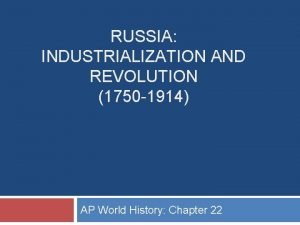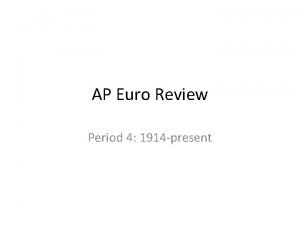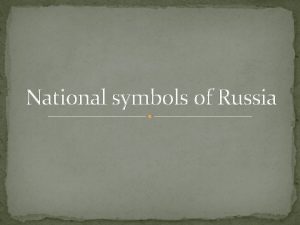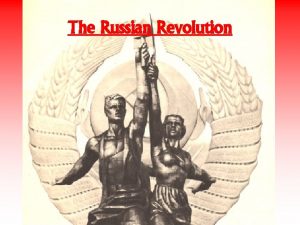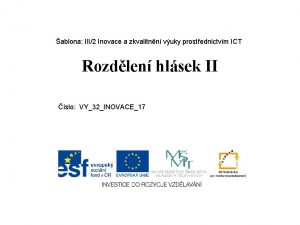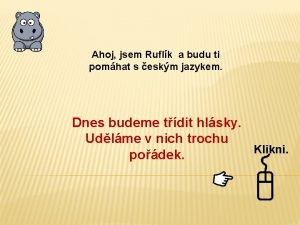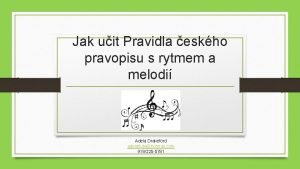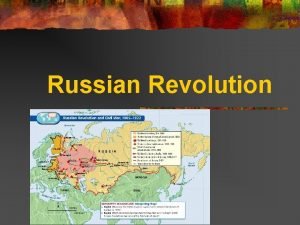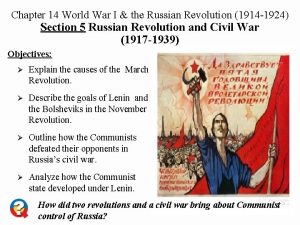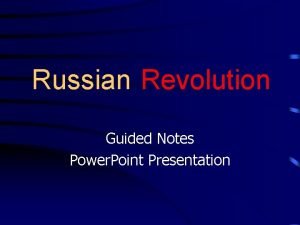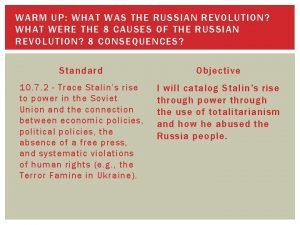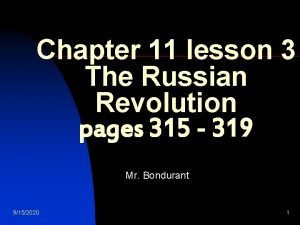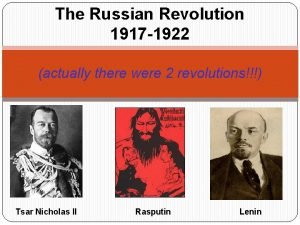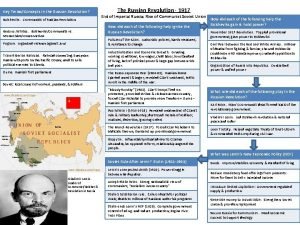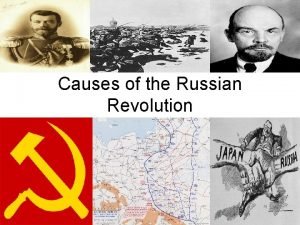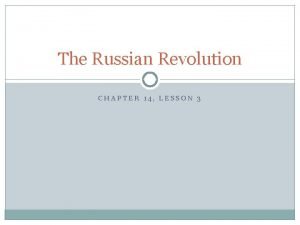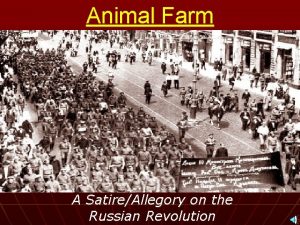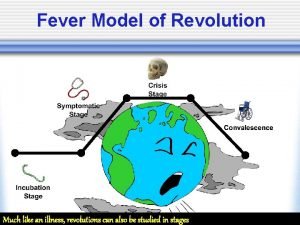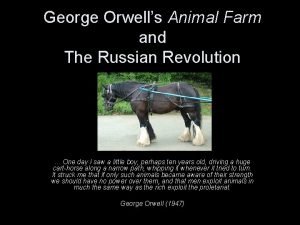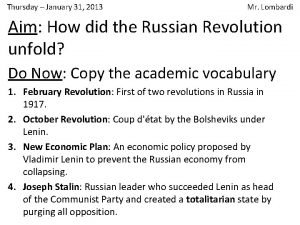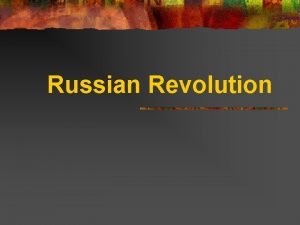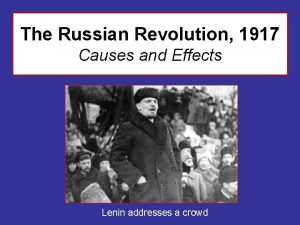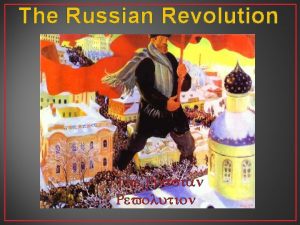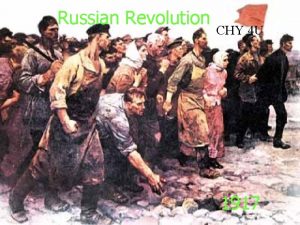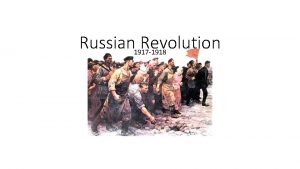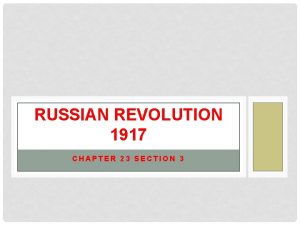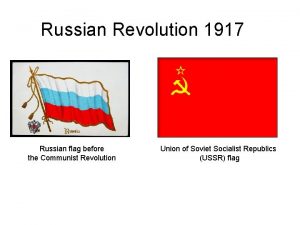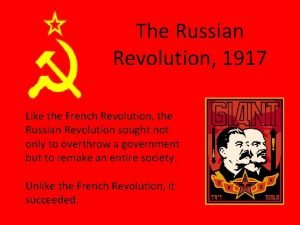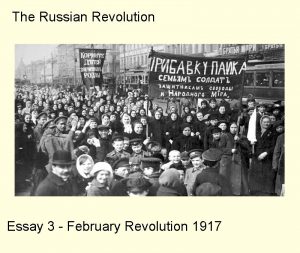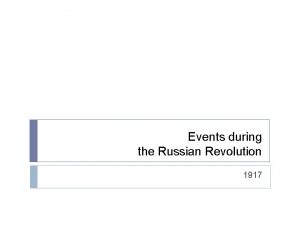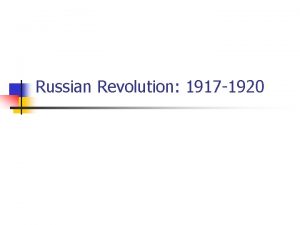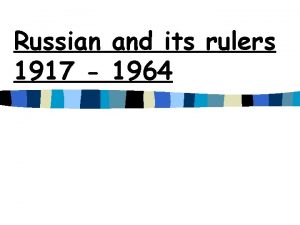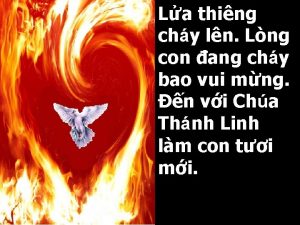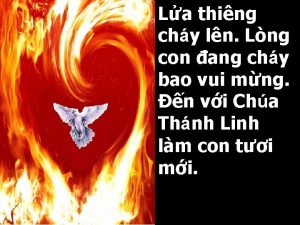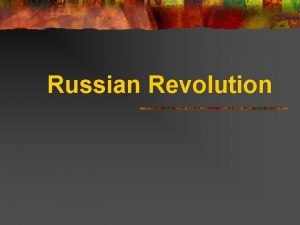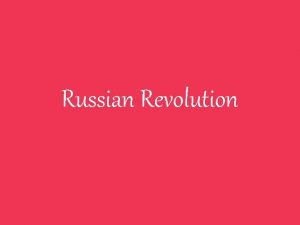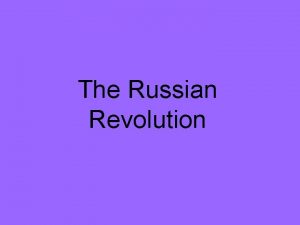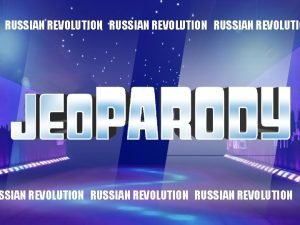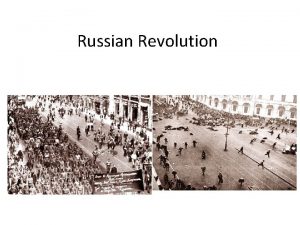Russian Revolution CHY 4 U 1917 Causal Triangle



























- Slides: 27

Russian Revolution CHY 4 U 1917

Causal Triangle Individuals Groups X Social forces/historical conditions

Two Revolutions • One to overthrow the Czar’s monarchy and establish a Provisional (temporary) Government = February 1917 = liberal • One to overthrow the Provisional Government = October 1917 = (sci) socialist Czar Nicholas II, last Romanov ruler after 300 years

Context: A Time of Change and Fear of Change After 1860 - Lost Crimean War (vs Britain, France and Ottomans) showing that Russia was weakening. - Czar Alexander II introduced Great (liberal) Reforms – including emancipation of 20 million serfs in 1861 - But he was killed and his successors introduced counter-reforms: - they were reactionary (censorship, tighter central control). Alexander II in 1861

Anti-Czarist Groups • Terrorists: – People’s Will, Land Freedom • Lenin’s brother was executed for plotting to kill the czar in 1887 • Marxists: – “sooner or later” the oppressed and oppressors would come into conflict and revolution would change the political system • Both were highly repressed by Czar’s secret police (Okhrana) Helen Rappaport, Conspirator: Lenin in Exile (London: Hutchinson, 2009), xxiv, xxvi.

Industrialization *Late industrialization • One shining example: in the 1890 s (textiles, Trans-Siberian railroad coal, iron, steel, oil, built in 1890 s railroads) – 5000+ miles long – connected European *Led to more problems: *rapid urbanization *lack of housing *poor working conditions. . . *. . . that created more pressure for change part of Russia with the Pacific – built with loans from France

From a 1914 book, this map shows how the railroad facilitated Russia’s version of imperialism Library of Congress, America, Russia and the Meeting of Frontiers, N. d. , http: //frontiers. loc. gov/intldl/mtfhtml/mfdev/devtransrail. html (May 8, 2016)

Russian Social Pyramid 1900 What evidence gives this 1900 cartoon away as being from a socialist perspective? Elite: Czar and family, aristocrats Russian Orthodox Church Czarist military officers Middle class (bourgeoisie) Poor, peasants, farmers, workers

Attempted Revolution in 1905 - Dissatisfaction, discontent and humiliating loss of the Russo-Japanese War led to protests: - Troops fired on peaceful protesters (Bloody Sunday) – see 1905 petition - Peasants seized land, armed uprisings, strikes - The Soviet (council) of workers was formed in St. Petersburg (all eventually put down by Czarist troops) - workers’ revolution, not socialist

Russo-Japanese War Editorial Cartoons – American Perspective Japan-in-America: the Turn of the Twentieth Century. 2008. http: //www. indiana. edu/~jia 1915/war/weather 27. html (Nov. 16, 2012). What do these primary sources suggest about how Russia was viewed?

Russian Propaganda


1905 Petition to the Czar “Sire! We workers and people of St. Petersburg…our wives, our children and aged and helpless parents, are come to Thee…to seek for truth and protection. We are become beggars, bowing under oppression and burdened by toil beyond our powers, scorned, no longer regarded as human beings, treated as slaves who must suffer their bitter lot in silence. And having suffered, we are driven deeper and deeper into the abyss of poverty, lawlessness, and ignorance. We have been strangled by despotism and arbitrary rule, and we have lost our breath. We have no more strength, Sire. The limit of our patience has been reached. There has come for us the grave moment when death is preferable to a continuation of our intolerable torture. ” How revolutionary does this sound? Quoted in Rappaport, Conspirator, 108.

What does this picture show about feelings after the failure of the 1905 revolution?

Nicholas II’s Reforms • Czar Nicholas II promised some reforms after the 1905 Revolution – a Duma, or parliament – a constitution with ministers responsible to the Duma, not the Czar (in theory) – Extension of the franchise (but this was pulled back over time) • But once in place the Duma supported the Czar who continued to have the most power The last Czar and his family

Marxists: Bolsheviks vs. Menshiviks • Bolshevik - Menshevik split in 1903 – Mensheviks were more orthodox and wanted to wait until revolution occurred (when conditions were ripe – more industrialization had pushed the workers into action) (majority) – Lenin and the Bolsheviks wanted to push revolution along by using professional revolutionaries – don’t wait (minority)

Political Power in the Duma 1. Liberals (KADETS) or Constitutional Democrats 2. Mensheviks (Orthodox Marxists - gradual revolution) 3. Lenin and his Bolshevik followers didn’t have any members at first 4. Octobrists (supporters of the Czar) 5. Monarchists 32 1 4 5 Power rotated between 1 and 4

World War I • Russia part of the Triple Entente • Faring very poorly in the war (5 million casualties, 1914 -1917) • Lenin’s attitude to war: – imperialist – capitalist – get out! – Lack of food and fuel on the homefront – Soldiers poorly equipped and fed History Learning Site: Russia and World War One, 2012, http: //www. historylearningsite. co. uk/russia_and_world_war_one. htm (Nov. 16, 2012). Pride in the Czar at the start of war

Eventually this became an anti-war poster. Which sentiments did it reflect?

February Revolution • Faith in the Czar and the Duma had deteriorated over the course of the war • Rioting spread (this time soldiers joined them, didn’t shoot them) • Duma asked Czar to abdicate (and his brother refused the job as well) • Established Provisional Government – to hold elections to a Constituent Assembly – write a new constitution – share power with the Petrograd Soviet (Menshevik socialists who coordinated with other Soviets Burning czarist emblems in Feb. 1917 in Petrograd (the city’s name had been changed during the war because St. Petersburg sounded too German)

Lenin’s Appeal to the People • Lenin returned from exile and created April Theses, 1917 To whom does his slogan appeal? – end the war – all power to the Soviets (don’t cooperate with the Provisional Gov’t) – Peace, Land, Bread • Was too popular and exiled again to Finland by the Provisional Gov’t Lenin’s ideas became more popular and Bolsheviks came to dominate the Soviets in Petrograd and Moscow

October Revolution • Bolsheviks picked the right time to overthrow the weak Provisional Gov’t – Nearly bloodless coup (overthrow) began and it only took three weeks for them to control Moscow – Then other cities – But they cancelled the Constituent Assembly after only winning a small number of seats Red Army

Civil War • Red (Communists) vs. Whites • Whites – Foreigners (why? ) – Czarists – others opposed to Bolsheviks • Red Victory - Red Army organized by Trotsky on Guard, 1920/21

Succession • Trotsky or Stalin

Lenin’s Death Lenin embalmed Lenin after his stroke, 1923 Lenin’s mausoleum

Curriculum Expectations • 1789 -1900 (background): – D 1. 4 Analyze key political events, issues and/or developments (e. g. emancipation of the serfs) and assess their impact – D 2. 2 Assess the impact of war (e. g. , Crimean War) – D 2. 3 Assess the impact of reform movements (e. g. , socialist, labour) – D 3. 1 Assess the impact of new social, economic or political ideas (e. g. , Marx)

Curriculum Expectations, con’t • The world since 1900 – E 1. 1 Analyze the impact of some key social trends and/or developments (e. g. , industrialization) – E 1. 3 Describe dominant economic systems and some key economic policies (e. g. , socialist/communist) – E 1. 4 Describe forms of government (e. g. , autocracy, dictatorship) and explain the political beliefs and/or ideologies that underpinned them (e. g. , Marxist. Leninist) – E 2. 1 Explain the main causes and consequences of some conflicts (e. g. , Russian Revolution)
 Industrialization definition ap world history
Industrialization definition ap world history Triple alliance ap euro
Triple alliance ap euro Russian revolution vs french revolution
Russian revolution vs french revolution Russian national symbols
Russian national symbols March 1917 revolution
March 1917 revolution Hy chy ky ry dy ty ny na zdi visí hodiny
Hy chy ky ry dy ty ny na zdi visí hodiny Chy china
Chy china Chy china
Chy china Hy chy ky ry dy ty ny básnička
Hy chy ky ry dy ty ny básnička Dvouhlásky
Dvouhlásky The russian revolution
The russian revolution Kzbho6asboc -site:youtube.com
Kzbho6asboc -site:youtube.com Chapter 27 world war 1 and the russian revolution
Chapter 27 world war 1 and the russian revolution Russian revolution guided notes
Russian revolution guided notes Russian revolution effects
Russian revolution effects The russian revolution
The russian revolution Russian revolution political cartoons and explanations
Russian revolution political cartoons and explanations Russia after ww1
Russia after ww1 Russian revolution
Russian revolution Causes and effects of the russian revolution
Causes and effects of the russian revolution Chapter 14 lesson 3 the russian revolution
Chapter 14 lesson 3 the russian revolution Animal farm summary
Animal farm summary Fever model of american revolution
Fever model of american revolution The russian revolution
The russian revolution Causes of the russian revolution
Causes of the russian revolution Http://www.history.com/topics/russian-revolution
Http://www.history.com/topics/russian-revolution Causes and effects of the russian revolution
Causes and effects of the russian revolution The russian revolution
The russian revolution
